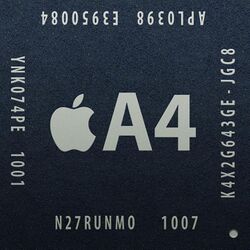Apple A4
Topic: Engineering
 From HandWiki - Reading time: 10 min
From HandWiki - Reading time: 10 min
 | |
| General Info | |
|---|---|
| Launched | April 3, 2010 |
| Discontinued | September 10, 2013 |
| Designed by | Apple Inc. |
| Common manufacturer(s) | |
| Product code | S5L8930X[1] |
| Performance | |
| Max. CPU clock rate | 800 MHz to 1 GHz |
| Cache | |
| L1 cache | 32 KB instruction + 32 KB data[2] |
| L2 cache | 512 KB[2] |
| Architecture and classification | |
| Application | Mobile |
| Min. feature size | 45 nm |
| Microarchitecture | ARM Cortex-A8 |
| Instruction set | ARMv7-A |
| Physical specifications | |
| Cores |
|
| GPU(s) | PowerVR SGX535[3] |
| History | |
| Predecessor | Samsung SL58920 |
| Successor | Apple A5 |
The Apple A4 is a 32-bit package on package (PoP) system on a chip (SoC) designed by Apple Inc. and manufactured by Samsung.[4][5] It was the first SoC Apple designed in-house. The first product to feature the A4 was the first-generation iPad, followed by the iPhone 4, fourth-generation iPod Touch, and second-generation Apple TV.[6]
The last operating system update Apple provided for a mobile device containing an A4 (iPhone 4) was iOS 7.1.2, which was released on June 30, 2014 as it was discontinued with the release of iOS 8 in September 2014. The last operating system update Apple provided for an Apple TV containing an A4 (second-generation Apple TV) was Apple TV Software 6.2.1, which was released on September 17, 2014.
Design
Apple engineers designed the A4 chip with an emphasis on being "extremely powerful yet extremely power efficient."[6] The A4 features a single-core ARM Cortex-A8 central processing unit (CPU) manufactured on Samsung's 45 nm fabrication process[7] using performance enhancements developed by chip designer Intrinsity (which was subsequently acquired by Apple)[8] in collaboration with Samsung.[9] The resulting CPU, dubbed "Hummingbird", is able to run at a far higher clock rate than previous Cortex-A8 CPUs while remaining fully compatible with the Cortex-A8 design provided by ARM.[10] The same Cortex-A8 used in the A4 is also used in Samsung's S5PC110A01 SoC.[11][12] The A4 also features a single-core PowerVR SGX535 graphics processing unit (GPU).[13] The die of the A4 takes up 53.3 mm² of area.[14]
The clock rate of the Cortex-A8 in the A4 used inside the first-generation iPad is 1 GHz. The clock rate of the Cortex-A8 in the A4 used inside the iPhone 4 and fourth-generation iPod Touch is 800 MHz (underclocked from 1 GHz). It is unknown what the clock rate of the Cortex-A8 in the A4 used inside the second-generation Apple TV is.
The A4 uses the PoP method of installation to support RAM. The top package of the A4 used inside the first-generation iPad, the fourth-generation iPod Touch, and the second-generation Apple TV contains two 128 MB LPDDR chips, providing a total of 256 MB of RAM.[15][16] The top package of the A4 used inside the iPhone 4 contains two 256 MB LPDDR chips, providing a total of 512 MB of RAM.[17][18][19] The RAM is connected to the A4 using ARM's 64 bits wide AMBA 3 AXI bus.[20]
Products featuring the Apple A4
Gallery
See also
- Apple silicon, the range of ARM-based SoCs designed by Apple.
- PWRficient, a series of microprocessors designed by P.A. Semi. Apple acquired P.A. Semi to form an in-house custom chip design department.
References
- ↑ "iOS 5.1 code hints at simultaneous A5X and A6 processor development". https://arstechnica.com/apple/news/2012/02/ios-51-code-hints-at-simultaneous-a5x-and-a6-processor-development.ars.
- ↑ 2.0 2.1 Cheng, Jacqui (March 14, 2011). "Ars reviews the iPad 2: big performance gains in a slimmer package / The Apple A5". Ars Technica. https://arstechnica.com/apple/reviews/2011/03/ipad-2-the-ars-review.ars/3.
- ↑ Klug, Brian; Lal Shimpi, Anand (June 30, 2010). "Apple's iPhone 4: Thoroughly Reviewed". AnandTech. http://www.anandtech.com/show/3794/the-iphone-4-review.
- ↑ "Updated: Samsung fabs Apple A5 processor". EETimes.com. March 12, 2011. http://www.eetimes.com/electronics-news/4213981/Samsung-fabs-Apple-A5-processor. "The company conducted a cross-section analysis of the chip that revealed details indicating Samsung made the chip in its 45nm process, the same process and fab Apple used for its previous generation A4 SoC."
- ↑ Clark, Don (2010-04-05). "Apple iPad Taps Familiar Component Suppliers - WSJ.com". Online.wsj.com. https://www.wsj.com/articles/SB10001424052702303912104575164112770784290?mod=rss_Today%27s_Most_Popular.
- ↑ 6.0 6.1 "Apple Launches iPad" (Press release). Apple. 2010-01-27. Archived from the original on 30 January 2010. Retrieved 2010-01-28.
- ↑ "Chipworks Confirms Apple A4 iPad chip is fabbed by Samsung in their 45-nm process". Chipworks. April 15, 2010. http://www.chipworks.com/A4_is_Samsung_45nm.aspx.
- ↑ Stokes, Jon (2010-04-28). "Apple purchase of Intrinsity confirmed". Ars Technica. https://arstechnica.com/apple/news/2010/04/apple-purchase-of-intrinsity-confirmed.ars.
- ↑ Merritt, Rick. "Samsung, Intrinsity pump ARM to GHz rate". EETimes.com. http://www.eetimes.com/news/latest/showArticle.jhtml?articleID=218600577.
- ↑ Keizer, Gregg (2010-04-06). "Apple iPad smokes past the iPhone 3GS in speed". PC World. http://www.pcworld.com/article/193597/Apple_iPad_Smokes_Past_the_iPhone_3GS_in_Speed_Test.html.
- ↑ Boldt, Paul; Scansen, Don; Whibley, Tim (16 June 2010). "Apple's A4 dissected, discussed...and tantalizing". EETimes.com. http://www.eetimes.com/showArticle.jhtml?articleID=225700447.
- ↑ "Microsoft PowerPoint - Apple A4 vs SEC S5PC110A01". http://www.ubmtechinsights.com/uploadedFiles/Apple%20A4%20vs%20SEC%20S5PC110A01.pdf.
- ↑ Khullar, Kunal (2017-09-13). "From A4 to the A11 Bionic: The Evolution of Apple 'A' mobile chips" (in en-in). https://in.pcmag.com/apple/116667/from-a4-to-the-a11-bionic-the-evolution-of-apple-a-mobile-chips.
- ↑ "Chipworks". 2010-09-21. http://chipworks.com/A4_is_Samsung_45nm.aspx. "The die was approximately 7.3 mm square, giving a die area of 53.3 mm²,"
- ↑ "Teardown of Apple's 4th-gen iPod touch finds 256MB of RAM". Appleinsider.com. 2010-09-08. http://www.appleinsider.com/articles/10/09/08/teardown_of_apples_4th_gen_ipod_touch_finds_256mb_of_ram.html.
- ↑ "Apple TV 2nd Generation Teardown". iFixit. 2010-09-30. http://www.ifixit.com/Teardown/Apple-TV-2nd-Generation-Teardown/3625/2.
- ↑ "Apple reveals iPhone 4 has 512MB RAM, doubling iPad - report". Appleinsider.com. 2010-06-17. http://www.appleinsider.com/articles/10/06/17/apple_reveals_iphone_4_has_512mb_ram_doubling_ipad_report.html.
- ↑ "A Peek Inside Apple's A4 Processor". iFixit. 2010-04-05. http://www.ifixit.com/blog/2010/04/a-peek-inside-apples-a4-processor/.
- ↑ Greenberg, Marc (2010-04-09). "Apple iPad: no LPDDR2?". Denali. http://www.denali.com/wordpress/index.php/dmr/2010/04/09/apple-ipad-no-lpddr2.
- ↑ Merritt, Rick (2010-04-09). "iPad equipped to deliver richer graphics". EE Times Asia. http://www.eetasia.com/ART_8800603321_499495_NP_1e1373d9.HTM.
External links
- MacWorld – Apple inside: the significance of the iPad's A4 chip
- CNET—Inside the iPad: Apple's new 'A4' chip
- HotHardware—iPad's Identity Crisis and Apple's A4 CPU Showstopper
- EETimes—Apple's A4 dissected
- Understanding iPad’s A4 Processor
- ARM Cortex-A series processors
- PowerVR GPU specifications pages
 KSF
KSF

